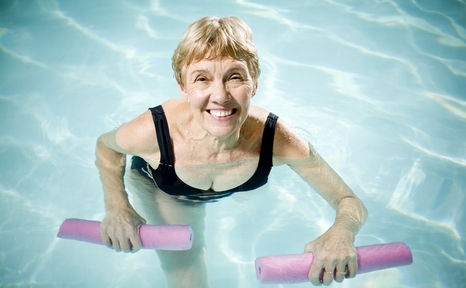


There was a time when doctors told arthritis patients to rest their joints and avoid exercise. These days, doctors agree unanimously that being active can help patients to minimize pain and increase function. Additionally, mobility, mood and quality of life can be improved through activity for people living with arthritis conditions.
People with arthritis are often reluctant to exercise because they fear they could injure themselves through activity. If this is a concern, patients can work with physical therapists and trainers to ease fears and to learn to exercise safely.
Exercise offers double benefits for arthritis patients. It can help to improve overall health, reduce the risk of disease and help to manage arthritis pain. People with arthritis who exercise regularly can expect less pain, increase in joint strength, better range of motion, improved function, and delay in disease progression.
For years, scientists have been interested in finding out how exercise helps joints affected by arthritis. Research has revealed that exercise can strengthen the muscles around the joints and help to them to stay flexible. Flexible muscles can support and stabilize joints much better than weak muscles do. Further, stronger muscles can help to relieve arthritis pain and prevent future pain if patients are staying active. Exercise can also relax stiff joints and increase range of motion. Additionally, exercise accelerates heart rate and breathing and also promotes the release of brain chemicals to help the body reduce inflammation and foster good mental and emotional health.
Doctors recommend that arthritis patients have a balanced workout program that includes range of motion exercises, muscle strength training, and endurance exercises. Before you begin any exercise program, it is best to check with your doctor — especially if you have not exercised before, are dealing with high levels of pain, or if you have had a surgical procedure.
Range of Motion Exercises. For most people with arthritis, range of motion exercises offer the most benefit. They involve stretching exercises that can help to minimize joint stiffness and increase range of motion in affected joints.
Muscle strength training. Strengthening exercises, such as lifting weights, can help to increase muscle strength. Strong muscles can help to support and protect your joints. Lifting weights can also help arthritis-affected joints to function better and minimize stiffness and pain.
Endurance Exercises. Endurance exercises increase breathing and heart rate for a period of time. Walking, swimming, dancing, jogging and even yard work are all examples of endurance exercises. You should build endurance up slowly, starting with five-minute increments and moving up to at least 30 minutes per day.
It is always important to listen to your body and not push yourself because doing so could lead to injury. Keep the following in mind:
• Always warm up before you begin exercising. Try stretching and walking for at least five to 10 minutes.
• Start slow and increase your activity slowly.
• Seek the advice of a professional and ask that person to help you to set rules to follow as you work out and progress.
• Listen to your body. If you are in pain, rest and do not exercise during a period of flare-up.
Once you have started exercising, you want to continue being active on a regular basis to produce the best results. Here are some ways to stay motivated:
• Make exercise a daily thing. When it becomes as routine as brushing your teeth, you are less likely to become unmotivated and stop.
• Make sure that exercise is easy and safe.
• Remember, exercise can be interesting, fun and social when you enlist friends and family to participate.
• Seize every opportunity to be active. Park your car farther away so you can walk, or walk instead of drive if your destination is nearby. Take the stairs instead of the elevator or stretch muscles often when you are working at your desk.
It is important to be as active as you can. Think of exercise as something you are doing for yourself so that you feel secure, focused and grounded. This is also the one time you can be alone to think freely and to be one with your mind, body and soul.
Copyright © www.orthopaedics.win Bone Health All Rights Reserved